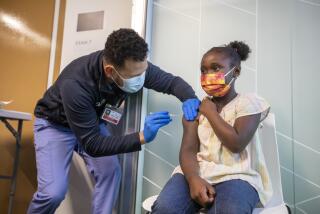U.S. Expected to Recommend Use of Goggles, Masks, Gloves : Protective Gear Urged for Dentists as AIDS Safeguard
- Share via
WASHINGTON — The federal Centers for Disease Control is expected to recommend that dentists wear protective clothing--masks, goggles and gloves--as standard procedure to protect both themselves and their patients from the possible transmission of AIDS, The Times has learned.
The agency, which is developing guidelines for health care professionals who perform “invasive procedures”--involving the release of blood or other bodily fluids--is also expected to recommend that surgeons follow approximately the same precautions. But surgeons have routinely worn protective garb and sterilized their equipment for many years to safeguard against the transmission of all infections.
However, the CDC is expected to recommend against regular screening of surgeons, dentists, nurses and others involved with invasive procedures for exposure to the AIDS virus. And, as it did earlier in its general guidelines for health care workers, the agency is expected to urge that health care professionals with AIDS be permitted to practice as long as they are capable of performing their jobs.
A CDC spokesman said the agency has “no data to suggest that AIDS has been transmitted from a health care worker performing invasive procedures, or from a patient back to the health care worker.”
Death of Surgeon
In a letter in the Oct. 17 issue of the New England Journal of Medicine, Dr. Jeffrey Sacks, a CDC official working in the Florida Health Department, described the case of a Florida surgeon who died of AIDS in 1983. According to Sacks, 400 patients operated on by the surgeon between 1978 and 1983 were monitored, and none had developed AIDS as of last August, although “we have no data on how many of them may have left Florida since their surgery.”
“This study of 400 persons found no evidence that transmission of AIDS to patients had occurred and nothing to suggest that the surgeon should not have been practicing,” Sacks said.
A source familiar with the CDC’s deliberations said that the major impact of the new recommendations concerning the wearing of protective clothing would be on dentists. “Surgeons have been doing that for at least a century in this country, but it hasn’t been traditional for dentists,” the source said.
Cathy Penesis, a spokeswoman for the American Dental Assn., called the proposed procedures for dentists “not really unusual” and said that her organization has recommended similar precautions since 1976 to shield against the transmission of hepatitis B and other infections. She acknowledged, however, that many dentists have not followed the guidelines.
‘Protects Both Sides’
“It’s something we have strongly urged as an infection-control measure because it protects both sides,” she said. “We think these (recommendations) will be supported. AIDS is not something that comes and goes like the flu. We’re talking about a fatal disease. I don’t think anybody would knowingly subject themselves to this risk when the consequences could be death.”
Dr. Neil Schram, chairman of the Los Angeles City-County AIDS Task Force, said that his group advised dentists several months ago to wear protective clothing with all patients. “Patients should insist upon their dentists doing it,” he said. The procedures protect both, he added, because “dentists don’t know who their high-risk patients are.”
In formulating its earlier guidelines for all health care workers, the CDC applied policies similar to those dealing with hepatitis B, considered a more transmissible virus than the HTLV-III virus that causes AIDS. Dentists, incidentally, are among the groups with the greatest risk of contracting hepatitis B.
AIDS, or acquired immune deficiency syndrome, destroys the body’s immune system, leaving it powerless to resist otherwise rare infections. It is transmitted sexually--in the exchange of bodily fluids such as semen and blood--and through the sharing of unsterilized hypodermic needles. Those at highest risk include male homosexuals and bisexuals, intravenous drug users and their steady sexual partners. As of Monday, there were 15,775 reported cases and 8,122 deaths.
Advisory Committee
The CDC proposed the new recommendations during a recent meeting at its Atlanta headquarters with an advisory committee composed of representatives from about two dozen organizations, including the American Medical Assn., the American College of Surgeons, the American Dental Assn., the American College of Emergency Physicians, the American Dental Hygienists Assn., the Assn. of Operating Room Nurses and the American Hospital Assn.
Its recommendations lack the force of law but carry considerable weight within the public health community. Although the new guidelines are not final--and are not expected to be until next month at the earliest--one source present at the meeting said that members of the committee appeared to have agreed on their substance.
“There was a long discussion that took place over a day, and I think a consensus developed,” said the source, who did not wish to be identified. “The discussion, ultimately, was more about what kind of details were worth spelling out and what could be left to the health care community.”
More to Read
Sign up for Essential California
The most important California stories and recommendations in your inbox every morning.
You may occasionally receive promotional content from the Los Angeles Times.













